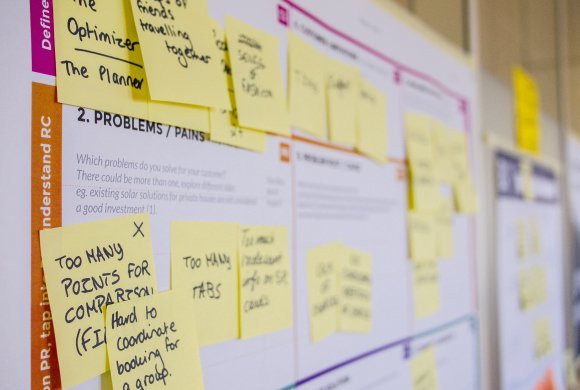Jared is a new hire at Triple E Electric Co. The company hired him because of his creative approach with his application package, and the innovative ideas he brought to his interview. When offered the job, he was told his creativity was one of the assets he brought to the organization and that the team looked forward to his contributions. But nearing 6 months in the job, Jared wonders whether any of it is true. Creativity has always been one a strength, but when he brings ideas to the table at staff meetings, they are met with resistance. Often, the team won’t even entertain a discussion, and recently he’s seen more than a few eye rolls when he brings up new ideas. He thinks maybe this isn’t such a great fit after all. Tonight he’s going to polish up his resume.
Most of us realize the importance of creative processes at work. We realize the necessity of staying creative and agile in a changing world economy. We understand creative solutions improve productivity and efficiency, and we know creativity allows us to accomplish more tasks with less money. If creativity is so valuable, why do many organizations resist creative approaches to change in favour of the way it’s always been done?
Jerry Wind, Marketing Professor at Wharton Executive Education at the University of Pennsylvania says this. “Old assumptions yield old results. We need leaders who embrace creativity, who encourage and support an innovative mindset throughout their organizations. Effective leaders create an environment in which everyone becomes more creative, and that creativity is encouraged and supported.”
Creativity is a hallmark of a great corporate culture, and, corporate culture is one of the biggest drivers for job seekers. In where era where they have lots of options, job seekers look for organizations that have the whole package – competitive pay, benefits and perks, and a great culture, which includes a welcoming environment for innovation. Millenials now make up the largest segment of the workforce. The old ideas referred to by Wind, the ones where it’s “all about business” and “productivity is king”, don’t work for this generation, nor by all indications, the one that is coming after. In order to attract and retain talent, organizational cultures must adapt to this reality or they will lose the best people to companies who do.
Even in today’s competitive hiring environment, many companies take the position that their corporate culture is what it is — and expect workers to adapt to it. This is a mindset that will no longer be tolerated by todays workers. Taking steps to build or enhance your organizational culture can help your business attract and retain the best people.
A Cultural Mindset Shift
How does an organization re-invent itself to adapt to the changing expectations of workers? By focusing on the biggest driver – creating an awesome culture. Here’s how.
DEFINE Your Current Reality
Before you can shift your culture, you have to examine what it currently is. This is not as easy as it sounds. Often, leaders’ perspectives of their corporate culture is far from what employees actually experience. The first step is asking your team to be honest about your culture. The best results will be gained by providing an anonymous survey and simply asking the question – how would you define the culture here? The results may surprise you, and you should be prepared for a few painful realizations, but without this information, it’s difficult to know exactly where you need to shift.
REFINE Your Desired Reality
Culture change must be intentional. You can’t just throw some team building activities into your calendar and call it culture. It needs to seep into everything you do so your team is connected to why they do what they do and how they go about doing it. And, it needs to be authentic. You can’t put on a Google or Netflix hat and try to recreate that culture in your organization. This can be a great opportunity to engage your team. Take the information you gleaned from defining your culture and ask your team what kind of culture they desire. Use your collective creativity to “blue-sky” what the perfect culture would look and feel like. Find someone from outside your organization to facilitate this process. If your team is involved at the outset, they will be highly motivated to move it forward and live it out.
SUSTAIN the Culture You’ve Created
Once you’ve refined the reality, you need to re-define it. This requires all the creativity you can muster. Put into words what your hard work has revealed. Make it part of the day-to-day activities of your team. Put it on big splashy posters. Find people living it out and celebrate those efforts publicly. Give recognition and even rewards for team members who really buy in and make it happen. Find ways to make believers out of those who are on the fringe. Help colleagues establish bonds that increase their desire to stay. Make it a significant part of your onboarding process so new hires immediately feel and see the cultural benefits and expectations of your organization. Unless there is intention around sustaining your culture, it is likely to fade away and become “something we did back in 2010”. The shift from “something we did” to “something we are” is significant. Culture is, in many ways, a living, breathing thing that needs to be nurtured and tended, led by example.
RECRUIT for Culture Ambassadors
Once you’ve defined, refined and found ways to sustain your culture, you need to be ruthless about who you invite to join that culture. As labour shortages continue, it’s tempting to settle for a body – anybody – to fill your vacancies. Reality may sometimes necessitate this, but if you can wait for the right person, you will continue building the amazing culture into which you put so much time and effort. It only takes a few employees who either don’t buy in or actively challenge the culture, for things to erode. Make seeking cultural fits a significant part of your recruitment process. You’ll not only benefit from someone who easily slips into their role and engages quickly with your team, but who will champion the culture they’ve joined. When team members choose to leave your company to pursue other opportunities, they will be your biggest ambassadors out in the world, building your brand even after they’re gone.
Corporate culture drives job satisfaction and job satisfaction drives corporate culture. Be creative in how you go about the process of making what is for many, a huge shift. You simply can’t continue to do what you’ve always done and expect to compete for quality talent in a tight labour market. Culture building may be the most important thing your company does as you move into the future.




